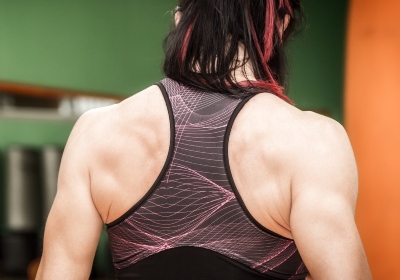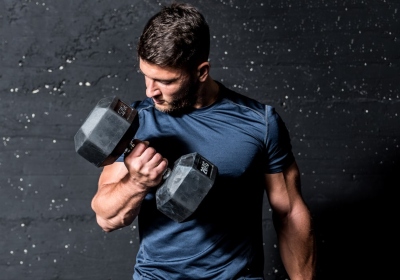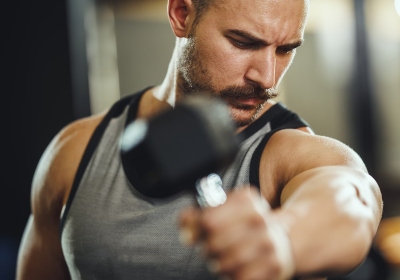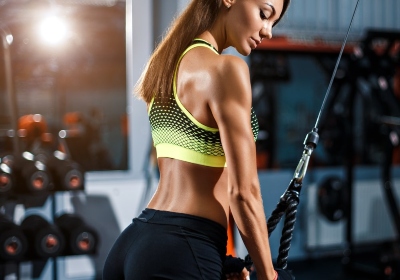VIDEO
Dumbbell Incline Bench Fly
- Biceps
- Triceps
- Trapezius
- Upper Back
- Shoulders
- Chest
Level:Intermediate
Trainer:Nick Taylor
Equipment:Bench, Dumbbell
Dumbbell Incline Bench Fly
- Biceps
- Triceps
- Trapezius
- Upper Back
- Shoulders
- Chest
Level:Intermediate
Trainer:Nick Taylor
Equipment:Bench, Dumbbell
Sit down on a bench with dumbbells in both hands. Bench should be set on 30 degree angle. Start lifting your arms above you with your palms facing together. Lower the weights in slow and controlled motion. Make a pause when the weights are in line with your shoulders. Use your chest and shoulders to drive the dumbbells back to the starting position.
save to ...
RECOMMENDED FOR YOU
- Biceps
- Gluteus
- Hamstrings
Duaration: 00:49
save to playlist
ARTICLES
The trapezius muscle is a crucial straight broad muscle that is located in a superficial position, in the back part of the neck and the upper back. The trapezius muscle has the shape of a triangle, the base facing the spinal column, and the top - to the acromion of the scapula. These kinds of muscles on both sides of the back together are trapezoidal.
There are three parts of it:
Upper part: Once the spine is fixed and raises the scapula. With a fixed shoulder blade, it straightens the head and neck.
Middle part: When the spine is fixed and the head brings the scapula to the spine. With the contraction of all parts of the muscles, the adduction of the shoulder blades also occurs.
Low part: It downs the shoulder girdle when the spine and head are fixed.
The upper trapezius muscles are trained by raising and lowering the shoulders with weights in the hands (performing shrugs). The lower part is trained by bringing the shoulder blades of the back under load.
Training.
Band Seated Row. Sitting on the floor with your legs extended loop an elastic band around your soles and hold one end in your right hand. Squeezing your shoulder blades and making a twist to the right with your torso, pull the band toward your waist. Then repeat the action to the other side.
Planche. It is an advanced gymnastic exercise. You should have a high level of fitness preparation and strong hands. It is the skill in which your body should be parallel to the ground supported by hands and arms with your legs raised.
S-Leg Pushup. Put your hands and toes on the mat. Keep your arms straight, but don't lock your elbows. Align your feet making the straight line with your arms and core. Inhaling, bend your elbows and lower your chest to the mat slowly. Straighten your arms to lift your core up, exhaling, at the same time lifting one leg off the ground.
P-up Variation. Put your hands and toes on the mat. Keep your arms straight, but don't lock your elbows. Align your feet making the straight line with your arms and core. Inhaling, bend your elbows and lower your chest to the bench slowly. Straighten your arms to lift your core up, exhaling.
Read more
Biceps is the most famous muscle in the human muscular system, it is approximately one-third of the mass of the shoulder. It is a part of a group of three in the upper arm that works together with each other to lift the arm toward the shoulder. As one of the most visible and impressive parts of the body, “two-headed muscles” are often the gym’s focus.
It is responsible for two main movements of the arm. The first is raising your hand. Those who carry something using their arm are likely to engage them in the process, as some upward force must be applied during the process of carrying and lifting. The second movement, for which they are responsible, is called supination, which rotates the arm from the natural position of the palm down to the palm up.
Biceps are built as a result of injury, which is often achieved through lifting weights such as curls or other types of exercises. As the curls or other exercises are done, the muscles in the arm get minor injuries. These injuries must be repaired naturally. The recovery process, as a natural byproduct, usually leads to growth and strength gains, although this process can take several weeks or months before noticeable results are seen.
Very few exercises work for it without affecting the other parts of the shoulder. Therefore, there is no reason to worry that others in the upper arm might be neglected by focusing on them. Some may focus only on the arm and almost completely forget about the legs or the core.
As one of the most commonly used muscles in the body, the biceps can certainly be damaged. Biceps injuries are not as common as some other types of injuries, there is always a risk, especially among weightlifters. The most common type of injury is damage to the tendon. In this type of injury, It is pulled away from the tendon that attaches it to the arm in a bone also known as the radius. Such injuries occur when they are used suddenly or to a level that they cannot handle.
Training.
Dumbbell Bicep Curls. Stand straight with the dumbbell in each hand and with your feet shoulder-width apart. Once the dumbbells are at your shoulder level, start slowly lower your arms to the starting position. Repeat for the desired amount of repetitions.
Incline Pushup. Place your hands slightly wider than shoulder-width apart on a bench, chair, or couch. And assume a high plank position with your feet together and your body straight from head to heels. Keeping your feet flat and core engaged lower your chest to the bench or chair. Pause. And then push yourself back up to the starting position.
Diamond Knee Pushup. With your knees on the ground place your hands on the ground with your fingers and thumbs touching together creating the diamond shape. This action will engage more your tricep muscle. Then complete a push-up and get back to the starting position. Repeat for the desired number of repetitions.
Pike Pushup. Assume a shorter push-up position, get on your toes and put your butt up, shifting your weights to the front. Bending your arms slowly lower your head, be sure not to bump your head on the ground.
Read more
The shoulder muscles are divided into two groups. The anterior group consists of flexors: the coracohumeral, the brachialis, and the biceps brachii. The posterior group includes the extensors: the triceps brachii and ulnar.
The coracohumerals start from the coracoid process of the scapula fuses with the short head of the biceps brachii and pectoralis minor and attaches to the humerus at the level of the upper edge of the brachial.
The brachials start from the lower half of the anterior surface of the humerus and the intermuscular septa of the shoulder and attach to the tuberosity of the ulna and its coronal process.
The biceps brachii has two heads starting on the scapula from the supra-articular tubercle (long head) and the coracoid process (short head). It attaches to the forearm to the tuberosity of the radius and the fascia of the forearm. It belongs to the bicarticular part. Concerning the shoulder joint, the biceps of the shoulder is the flexor of the shoulder, and the elbow is the flexor and instep support of the forearm.
The triceps brachii is located on the back of the shoulder, has three heads, and is a bicarticular. It participates in the movements of both the shoulder and the forearm, causing extension and adduction in the shoulder joint and extension in the elbow.
The ulnar starts from the lateral epicondyle of the humerus and radial collateral ligament and the fascia; it is attached to the upper part of the posterior surface and partly to the olecranon of the ulna in its upper quarter. The function of this is to extend the forearm.
The bundles of the deltoid muscle perform different functions, so it will not work to load them all with one exercise: you will have to include at least three movements in the training. All exercises are divided into three parts: for pumping the front, middle and back beams. Pick exercises from our list below and add them to your workouts. The weight is necessary so that the last repetitions in the approach are given not easily, but without compromising the technique. You can train your shoulder straps both at home and in the gym. But it is necessary to have a bar and a gantry. Weight must be chosen in such a way that in every set it was possible to raise the average 8-10 times. This is how you can increase the volume and mass. If the same goal is set - to increase the strength, to train in the face of more severe conditions. In this case, the number of repeats will be 5-8. The number of reps is 4-5.
Barbell bench press. Take the shell on your chest, bring your elbows forward, tighten your abs, buttocks, legs. Squeeze the bar up, lower it back and repeat. When the bar passes your face, do not lift your chin, but squeeze it in yourself: this way the bar will go along the optimal trajectory. If the projectile remains in front of the body at the top point, and not above it, the load on the lower back increases. Therefore, try to take the barbell behind your head.
Standing dumbbell press. Raise your arms with the selected weight to shoulder level, turn your palms forward with your fingers. Squeeze the dumbbells up and take them slightly behind your head, and then lower them to the starting position and repeat. Do three to five approaches 10-12 times.
Seated Bent-Over Dumbbell Routing. Sit on a bench, tilt your body with a straight back, as far as flexibility allows, hold the dumbbells in your lowered hands. Without changing the position of the body, spread your arms with the taken weight on the sides to shoulder level. Slowly lower the dumbbells to the starting position and repeat.
Read more
This time we suggest paying special attention to the chest muscles. It is this zone that many athletes want to pump, but it is not so easy to do and one classic chest press is not enough.
Chest muscles are one of the most complex and largest muscle groups.
Therefore, competent training must be a combination of basic and isolation exercises. Only in this way, it will be possible to load the muscles at different angles. Exercises with barbells are suitable for increasing muscle mass, and with dumbbells, on blocks and training machines - for improving the form and detailed elaboration. These exercises also activate the stabilizing muscles.
Imagine that the chest muscle is a rubber band that connects the shoulder, collarbone, and sternum. If you lift your arm to the side and then pull the elastic band, it will move your shoulder forward. You do this movement all the time in your normal life like when you close a door, push something away with force, or elbow your jaw.
Most pectoral muscle exercises repeat this movement. The only difference is that they also use a barbell, dumbbells, or crossover slings to create extra resistance.
The chest muscle has two heads: an upper head (clavicle) and a lower head. Their functions are slightly different, and this is important. In order to have a symmetrical chest, you need to pump both heads.
The fibers of the clavicular head are directed upward, so you need to move the shoulder forward from the bottom to the top for additional exercise.
Many people believe that the more they pump their chest, the faster their muscle mass will increase. In fact, this has a negative effect on muscle growth. The muscle gets bigger during rest when the tissues are recovering from an active workout. There are a few tips on how to properly pump your pecs and not overtrain:
Exercise no more than 2 times in 7 days. In between do physical exercises on other parts of the body;
Do not exercise for more than 45 minutes, as this may cause muscle size and strong growth to regress.
Exercises that help you to pump the chest muscles include:
push-ups.
bench presses.
triceps push-ups.
To pump your muscles evenly, alternate your exercises. The bench press is great, but you don't have to do it in every workout, because there are other good options.
Choose the weight so that the last reps in an attempt are difficult. If you find it easy and your muscles don't tire, they won't grow.
Avoid flying in the clouds during the workout: concentrate on the muscle work. It really helps you to pump it better.
Perform 3-5 sets of 8-12 reps. Do not use weights that are too heavy. Especially at the beginning if you do not have a good command of technique.
Read more
The muscle on the back of your shoulder is called the triceps. Triceps originate from the scapula and humerus and attach to the ulna using the triceps tendon. The triceps muscle does the function of extension in the elbow and acts as an auxiliary in the implementation of other movements in the shoulder. During triceps contraction, the vector of movement is transmitted using the tendon.
The mass fraction of the triceps is approximately 2/3 of the muscles of the shoulder, so its size plays a critical role in the formation of beautiful arms. By focusing on the biceps, and forgetting about the triceps muscle, athletes contribute to getting inharmoniously developed arms.
You shouldn't train your triceps more often than 1-2 times a week. Do not forget that many exercises for the pectoral muscles load the triceps, so make up the training program so that the triceps and pectoral muscles are trained on different and distant days, thus some periodization of the load is achieved.
But in some cases, the triceps can be trained on the same day as the pectorals, since all basic chest exercises involve the triceps and vice versa. This means that if you swing your chest, then the triceps already swing by themselves. To increase efficiency, do triceps workouts of different intensities: light-medium-hard, and so on. Rest for at least 1 week after a hard workout.
In classic splits, the triceps are usually the most overloaded muscle, due to the very specifics of training in split programs. To increase the volume of the triceps muscle, do 8-15 repetitions. The total number of triceps sets (the sum of the sets of all triceps exercises) is 3-6.
The basic exercises for pumping triceps are reverse push-ups on the bench and narrow grip barbell press. In addition, an important exercise is a pull of the upper block with a rope - one of the few that uses the lateral head in the work. Since the mechanics of movements are in many ways similar, it is recommended not to combine the presented exercises, but to alternate.
Training.
Reverse push-ups from the bench. Starting position - heels touch the floor, hands on the bench behind your back. Slowly lower your torso down, linger at the bottom point, then with an explosive force push your body weight up over the bench. The elbows are directed backward. To complicate things, use an extra load by putting the weight on your hips.
Bench press with a narrow grip. It’s the exercise to work out the medial head of the triceps. Lie on a bench (keeping your feet firmly on the floor), grab a barbell or dumbbell with a narrow grip, then lift the weight up. During execution, the elbows should be pressed as close to the body as possible.
Bent over triceps extension. It’s for pumping the long and lateral heads of the triceps. When pulling the arm back, make sure that the elbow does not change position (that is, do not swing the arm back and forth or left and right). Also, watch out for the arch of the back - to do this, keep the abs slightly tense.
Top pulldown with rope. A key exercise for pumping the lateral head of the triceps. The movement should be in the lower plane - that is, do not raise your arms higher than chest level. When doing it, make sure that the elbows do not change position, and the body does not swing.
Remember that when building the triceps, you need to correctly feel the amplitude of the exercises - achieving maximum involvement of the muscles without dangerous impact on the shoulder joint. For this, it is better to use an average working weight.
Furthermore, watch your shoulders and head - in particular, don't round your shoulders or lean forward. When doing triceps exercises, the chest should be open, the press should be tense. Otherwise, the load is transferred to the shoulder joints.
Read more
SAVE TO ...





